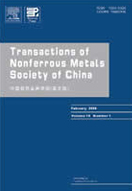Role of nickel alloying on anodic dissolution behavior ofzinc in 3.5% NaCl solution. Part II: Potentiodynamic,potentiostatic and galvanostatic studies
(Chemistry Department, Faculty of Science, Sohag University, Sohag 82524, Egypt)
Abstract: Zinc is common metal used for steel protection from corrosion. The addition of further element, such as Ni, can modify the corrosion rate and maintain sacrificial protection. The anodic dissolution behavior of Zn, Ni and Zn-Ni alloys with different Ni contents (from 0.5% to 10%, mass fraction) in 3.5% NaCl solution was investigated using potentiodynamic, potentiostatic and galvanostatic techniques. The composition and microstructure of the corrosion layer on Zn, Ni and Zn-Ni alloys were characterized by energy-dispersive X-ray spectroscopy analysis (EDX) and scanning electron microscopy (SEM). The galvanostatic curves show that the anodic behavior of all investigated electrodes exhibits active/passive transition and the tendency of the alloys to passivity decreases with the increase in Ni content, except for 99.5Zn-0.5Ni alloy. While the potentiodynamic curves exhibit active passive transition only for pure Zn. Surface analysis reveals the presence of oxides, chlorides and metal hydroxide chloride in corrosion products, and very small cracks are observed for 90Zn-10Ni alloy compared with that of Zn.
Key words: corrosion; NaCl solution; Ni content; Zn-Ni alloy; anodic behavior

